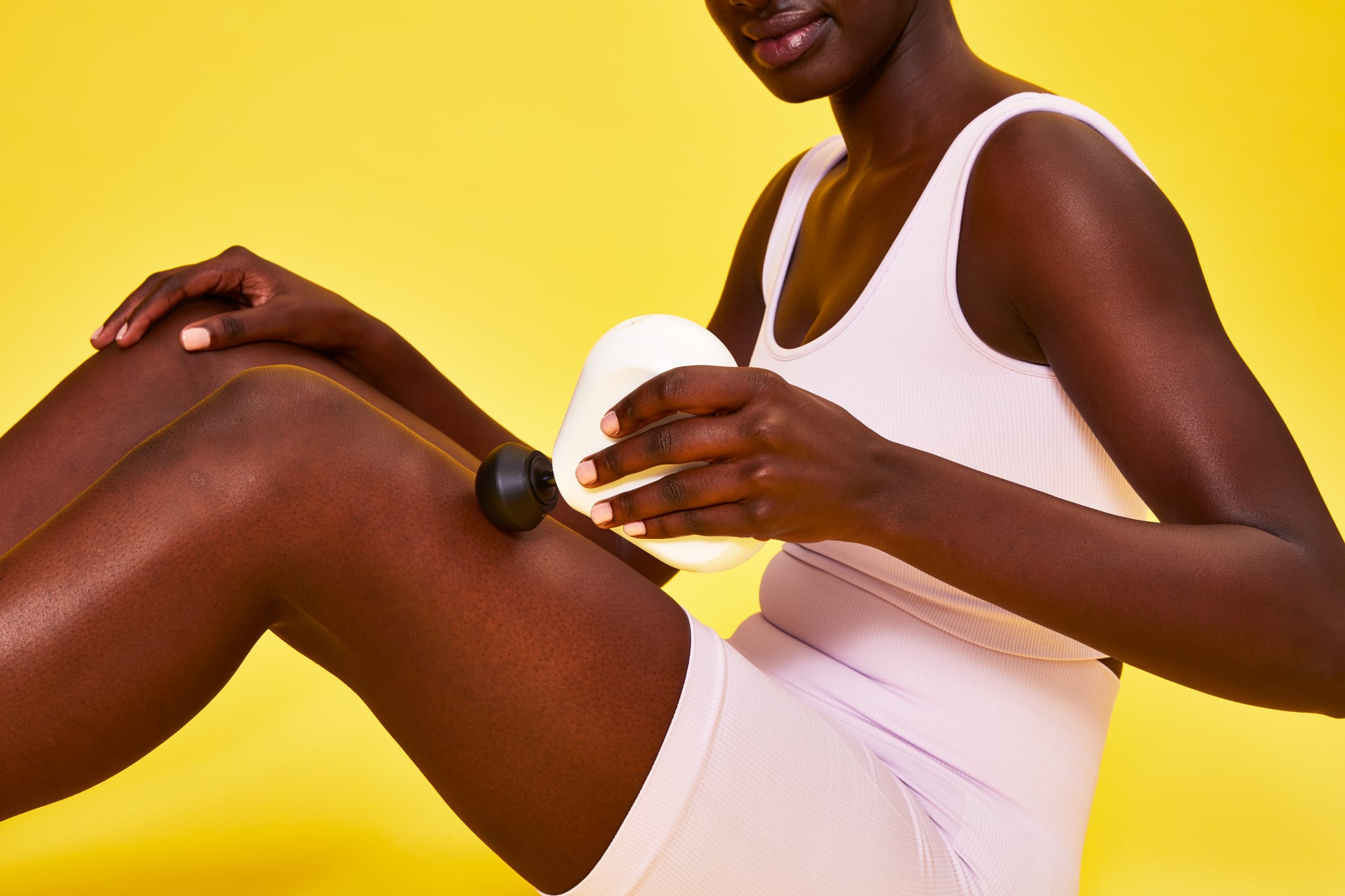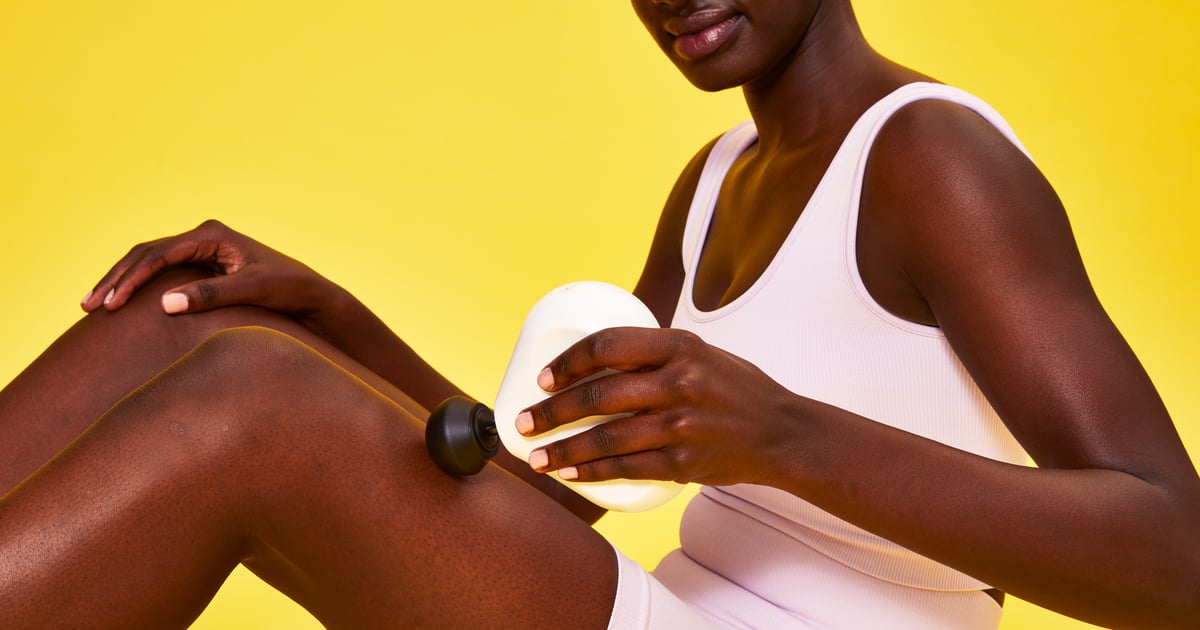Products You May Like

Making eye contact with your gym crush in the weight room mirror. Scraping your shins when pulling the deadlift bar. There’s no shortage of things that can make you uncomfortable at the gym. But the most common discomfort — the discomfort of sore muscles — usually happens after you’ve finished your workout.
Put simply, muscles get sore because when you work them, tiny microscopic tears get shorn into the muscle fibers. Once repaired, these fibers (and therefore, your muscles) are stronger than they were before, says exercise physiologist and certified strength and conditioning coach Sharon Gam, PhD, CSCS. However, for the first 72 hours (or so) after you exercise, the damage creates an inflammatory response in the body, she explains. “If your muscles are sore and you feel stiff, it’s a result of the inflammation that takes place ahead of the healing process.”
While some muscle soreness is normal, you probably want to get the soreness to subside ASAP so you can go back to walking up the stairs without groaning. Good news: There are things you can do to relieve sore muscles after a workout. “Generally speaking, anything you can do to support the muscle repair and recovery process will also help with soreness,” says Dr. Gam.
Ahead, fitness experts outline seven of the best strategies for simultaneously supporting muscle repair and minimizing muscle soreness — and one common treatment you should skip.
How to Relieve Sore Muscles
1. Get enough sleep
“Getting enough rest is essential to supporting muscle recovery modulating muscle soreness,” says certified personal trainer Ellen Thompson, Head Personal Trainer with Blink Fitness. It’s during sleep that our bodies release the highest amounts of human growth hormone and testosterone, which support muscle growth and repair, she explains.
In one 2015 study out of the University of South Dakota, researchers found that the less sleep an Olympic hockey player got after a hard day of training, the more intense their soreness was the following day. Meanwhile, in another study, those who slept less than six hours per night had poorer recovery — and therefore experienced symptoms of inadequate recovery like soreness — compared to those who slept seven (or more) hours.
Your move: Aim to get at least 7 to 9 hours of quality sleep per night to help relieve sore muscles and support recovery, suggests performance and nutrition coach Seamus Sullivan, CSCS.
2. Stay hydrated
Water, that is. “Hydration is very important for muscle recovery,” says certified strength and conditioning coach Jake Harcoff, CSCS, head coach and owner of AIM Athletic. “When you exercise, your muscles generate a lot of heat, and your body sweats as a way to cool it down,” he explains. If you don’t replenish this fluid loss after the exercise, there’s an increased risk of dehydration.
Dehydration can cause a number of symptoms such as headaches, irritability, tiredness, and dizziness — but many people don’t realize it can also increase the prevalence of muscle soreness, muscle cramps, and muscle spasms. Why? Well, “when you are dehydrated, the body is not able to clear metabolic waste from muscle breakdown as efficiently,” explains Harcoff. “Dehydration also reduces blood volume and decreases the amount of oxygen and nutrients that reach the muscles, which impedes recovery.”
Maintaining adequate hydration levels is therefore essential to ensure that muscles receive the necessary oxygen and nutrients to recover and repair after exercise, says Harcoff. How much water should you drink, exactly? To support muscle recovery and prevent muscle soreness, at least half of your body weight is in ounces of water per day. For example, a 150-pound person should aim to drink 75 ounces of water per day, he says.
3. Eat enough food
Nothing impedes muscle recovery and therefore prolongs muscle soreness quite like eating too little. “The body needs adequate energy and nutrients to repair and rebuild the muscle tissue that was damaged during exercise,” says Harcoff. When you’re not giving your body enough fuel to support recovery, your body may break down muscle tissue to obtain the energy and nutrients it needs, leading to decreased muscle mass and strength, he explains.
Getting enough food to fuel your body’s recovery can be as simple as making sure you’re eating a nutritious meal within a few hours of your workout and otherwise following your body’s cues to eat when you’re hungry. If you’re inclined to get more granular or would like more guidance on nutrition especially as it supports your fitness goals, consider speaking with a registered dietitian or other medical professional who can help give you personalized advice.
4. Prioritize protein
The number one nutrition priority is getting enough food, but what you eat after a workout matters, too. While carbohydrates and fat certainly play a role in muscle recovery, protein is especially important, according to Harcoff. Protein is made up of building blocks called amino acids, which the body uses to repair muscle damage, he explains.
As a general rule for daily protein intake, the American College of Sports Medicine recommends consuming somewhere between 1.2 and 1.7 grams of protein per kilogram of body weight, which equates to 0.5 to 0.8 grams of protein per pound of body weight. (For example, for someone that weighs 130 pounds, that’s between 65 and 104 grams of protein per day).
If you can, Harcoff suggests having a post-workout snack (or meal) containing carbohydrates and protein — ideally in a 2:1 ratio — within 30 to 60 minutes. “There does exist a window of time after exercise when the body is primed to take in and utilize nutrients consumed from food to replenish glycogen stores and provide the amino acids necessary for muscle repair and growth,” he explains.
5. Try foam rolling and gentle movement
Despite what their infrequent use might lead you to believe, foam rollers aren’t just gym decorations — they’re effective recovery tools.
Foam rolling, which involves rocking back and forth against a foam tube, is a type of self-myofascial release, explains Harcoff. “Using a foam roller to apply pressure to your muscles can help release tension, alleviate pain, as well as release knots and adhesions,” he says. Foam rolling has also been shown to increase blood flow to the area in question, which may also play a role in the activity’s ability to relieve soreness.
On that note: super gentle movement, such as walking or cycling, can also help relieve sore muscles by increasing blood flow — but keep it chill. (Here’s everything you need to know about working out with sore muscles.)
When using a foam roller, it’s important to focus on areas of tension and discomfort and to use proper form to avoid injury. “The pressure of the roller against your muscles should be firm, but not painful,” says Harcoff. If you’re wincing from the pain, you can actually cause the opposite of the desired effect. “When you’re in pain, your body goes into protection mode, which results in muscle-clenching,” he explains. This can increase, rather than decrease the soreness.
6. Consider heat therapy
Cue Nelly, because your sore muscles want it to get hot in here. “Heat therapy helps relax muscles, and increasing the blood flow helps healing and decreases stiffness,” explains Thompson. Blood carries nutrients like protein, vitamin B, and vitamin C (to name just a few) that help the body repair muscles, she explains, so increasing blood flow to the damaged area can help support recovery. Indeed, one 2017 study published in the Clinical Journal of Sports Medicine found that when applied immediately after heavy exercise, heat therapy can help reduce delayed-onset muscle soreness.
Most commonly, heat therapy is applied via a warm compress or heat wrap. However, taking a hot bath, hopping into a hot tub, or sitting in a sauna after your workout can also help.
7. Or cold therapy
Hate heat? Muscles feel tender to the touch? Switch your playlist to Vanilla Ice because ice therapy may be the more optimal relief protocol for you. Be it through an ice pack, cold plunge, cryotherapy, or a (very) cold shower, “cold therapy can provide relief for sore muscles by reducing inflammation and swelling,” says Thompson. Indeed, a 2021 study published in the Journal of Physical Therapy In Sports found that cold immersion can reduce the pain from muscle soreness. For the greatest relief, research shows applying cold within an hour after exercise is best.
To be clear: Whether you opt for ice or heat therapy is up to you. “The research isn’t clear on which one is better, so it comes down to personal preference,” says Dr. Gam. Because some people feel better with heat while other people feel better with ice, she recommends trying both separately. “You can also try a contrast application where you alternate heat and ice for about 10 minutes each for an hour,” she says.
Can You Take a Pain Reliever For Sore Muscles?
Raise your hand if you immediately pop some ibuprofen or aspirin when you’re even a little uncomfy. If your hand is up, odds are you’re inclined to reach for the same bottle when dealing with muscle soreness. But actually, Harcoff usually recommends against using NSAIDs (non-steroidal anti-inflammatory drugs) like Advil, Mortin, or Aleve for muscle soreness.
“While NSAIDs can offer temporary relief from muscle soreness, some research suggests they may hinder the body’s natural healing process and impede muscle growth,” Harcoff explains. Inflammation plays a vital role in muscle repair and growth, so by suppressing inflammation, NSAIDs might interfere with these positive adaptations, he says.
“The effects can vary based on individual factors such as dosage, duration of use, and the specific NSAID employed,” he says. But in most cases, you’d be better off employing one (or more) of the above sore muscle relief strategies instead. And if you’re really in pain — specifically, if you have excessive muscle soreness, muscle swelling, or dark urine, or are sore for more than a few days — a healthcare provider, not your medicine cabinet, would be a better first step.
Image Source: POPSUGAR Photography / Chaunté Vaughn
Product Credit: Capittana Crop Top, Capittana Biker Shorts, Clare Vivier Leopard Sweatshirt, Apl Sneakers, Kris Nations Earrings
